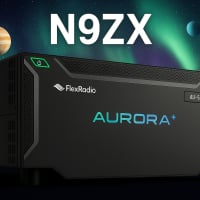SmartSDR v4.1.3 | SmartSDR v4.1.3 Release Notes
SmartSDR v3.10.15 | SmartSDR v3.10.15 Release Notes
The latest 4O3A Genius Product Software and Firmware
Need technical support from FlexRadio? It's as simple as Creating a HelpDesk ticket.
FlexRadio Aurora 500W HF Radio

FlexRadio has developed a new HF transceiver with a 500W output on 160-10m HF bands (200W on 6m). This radio does not use a legacy RF exciter followed by a linear amplifier. Instead, it uses a transmitter that employs Polar Modulation (PM). With PM, the radio still generates traditional SSB, CW, FT-8, RTTY, and all the standard on-air signals.
A 500-watt transceiver with an integrated automatic antenna tuner (ATU) in a single unit offers a few clear advantages, especially for seasoned operators who value simplicity and efficiency. First, it reduces the need for interconnecting multiple devices, which cuts down on cabling, potential RFI issues, and the complexity of station setup. This integration can also streamline operations, as the ATU and amplifier are designed to work in harmony, often offering faster tuning and better protection for both the radio and the amplifier. Another big plus is the space-saving aspect—ideal for both compact home stations and portable setups where minimizing gear is a priority
Aurora provides significant benefits over transceivers with linear amplifiers. The polar modulation technique (details below) is significantly more efficient than linear amplification. This change to the transmitter yields significant power savings, generates less heat, resulting in the need for a much smaller heat sink, which also reduces size and weight. It is the most significant advancement in amateur radio transmitter technology in the last 50 years.
By adopting the proven architecture of the FLEX-6000 and FLEX-8000 series and maintaining compatibility with SmartSDR, Aurora offers a familiar yet powerful upgrade path for today’s FlexRadio operators.
Introduction to Polar Modulation:
Polar modulation is a highly efficient signal transmission technique that separates a radio frequency (RF) signal into two fundamental components: amplitude (envelope) and phase (angle) components, allowing each to be amplified independently and more efficiently.
Unlike legacy linear amplification methods, which require power-hungry and heat-intensive amplifiers to preserve signal integrity, polar modulation enables the use of switching-mode amplifiers (such as Class D, E, or F) that operate with significantly higher efficiency.
Originally proposed in the 1950s by Leonard Kahn through his Envelope Elimination and Restoration (EER) technique, polar modulation has seen renewed interest with modern digital signal processing (DSP) capabilities.
It offers a compelling path forward for amateur radio, enabling cleaner, smaller, and more energy-efficient transmitters that challenge the long-standing dominance of legacy linear amplifier designs.
Comments
-
This is an interesting idea. I wonder if there are any plans to offer polar modulation in a traditional 100 watt radio like the 6/8000 radios. The liter weight and all in one box is great for portable operation, but 500 watts is lite for the regular old rag-chew and contest types and overkill for driving an amplifier.
Just thinking,
0 -
I'm personally very tempted. I operate almost 100% CW and Digital, rarely voice. I have 6400/6600 and a pair of TGXLs and PGXLs and really don't ever op above 350 to 500 watts. Seems like an ideal way to dump a few tuners and amps and radios.
1 -
I have an Elecraft K3 and Collins 30L-1 amplifier. I am exploring using AU-520 for my next level. I sure hope delivery is before I pass away (78yo) LOL. My station is near lots of noise sources (modem/router/ 24 channel switch/RAID drive/two PCs/electronic work bench). Moving to closet where antennas come in would greatly help with noise by operating remote. I think that would do wonders for my hearing the weak ones.1
-
oh stop your wallet is as young as you feel. I recommend using your wallet three times a week to keep it in shape
2 -
500 watts is only 3Db (half an S-unit) down from 1000 watts. To increase a full S-unit from 500 watts output requires 2000 watts output.
0 -
Yeah 500W is a sweet spot. Only 1/2 an S-unit down from a KW!
1 -
Even though FlexRadio has outlined the SmartSDR Software Update and their 3 Tier Approach. We still have questions. Questions or the Scenario I keep getting asked….. I order a Aurora, the assumption is it comes with 4.0.1…. Loaded in the unit. Is 4.0.1 ACTIVE in the radio when I get the Aurora? Or does it come Loaded but NONE of the Unique Features are Active yet? Will I still be expected to pay the $149 or $199 to then download the software that will be active? Let's be clear…… Do I pay $9K+ then get the radio and expected to pay another $199 to fully activate the $9000+ Aurora?
0 -
The Aurora radios will be fully activated. Just not all of the new features in SmartSDR version 4.
The Aurora radios, just like all of the new radios ( 8000 series) comes with version 4 Basic of SmartSDR installed. If you ( or I ) want the Plus upgrade or the Early Access upgrade, it will cost $199 for SmartSDR Plus or $299 for SmartSDR Early Access.( depending on which license you want) Those versions license will be good for one year of any new features that come out from the date of purchase. You will retain all new features even if you do not renew your license. And you will continue to get bug fixes for free. The prices I quoted are what the two licenses will cost after November 30th when the $50 off special expires. The reason I quoted the standard prices is because the Aurora radios won't start shipping until sometime in December well after the special promotion ends.
James
WD5GWY
0 -
Also, so you know, if you or I purchase SmartSDR Plus, we will have to wait 30 days from the date any of the new features in that particular release ( from the date the new features were released) before the new features are activated. If on the other hand, we purchase the Early Access version, the new features are activated immediately. The Early Access license also gives you and I a method to interact with the development team at Flex Radio and provide feedback on issues encountered with the new features. And we can also provide ideas for new features. Both license methods have their pluses and minuses. Personally, I prefer the Early Access because it offers not only immediate access to new features, but a chance to help clear up bugs before everyone has to deal with them.
James
WD5GWY
1 -
Just my opinion (and we all know about opinions :-) ), but given the price of an Aurora (and perhaps even the the 8600), I would suggest throwing in the first year of SSDR for free. It will buy you goodwill and not make customers feel like they are getting nickel and dimed to death. Revenue hit is likely insignificant. For the record I own an 8400 so no dog in the hunt.
2 -
Agree with above comment, new Aurora purchase should include free software with the upgrades for one year from date of shipment. No jacket or coffee tumbler, no real cost for Flex to offer this.
Mike
N9ZX
1 -
I agree that it would be nice if Flex Radio would allow a one year license to v4 Plus for owners of the 8000 and Aurora radios. But, at the same time, I can see a problem that might occur. The 8000 series radios have been available for quite some time now. So, in order to be fair to everyone who has already been using a 8000 radio for quite some time now, they would have people that purchased a 8000 series radio prior to version 4 being released feeling like Flex Radio should make SmartSDR Plus available to them as well as new purchasers of the 8000 radios. While to us, this sounds like the right thing to do, it might not be what Flex Radio considers fair. They do have a lot of money invested in SmartSDR's development. And I imagine if they really are going to put more ( paid) developers to work on improving SmartSDR and adding new features, someone has to pay the cost. And like anything else, it's the customer who provides the money to pay for the improvements and new features. I would like to get a one year license for SmartSDR Plus with the new Aurora radio I am ( not so) patiently waiting for. But, from everything Flex Radio has published that doesn't appear to be the case. I have gone this far with the new radio and I will bite the bullet and do whatever it takes to get to Early Access just so I can provide better feedback to the developers. At my age, it's not going to make a huge difference if I don't spend the money on a new Aurora. I don't think my heirs will be will to sell everything I have and put the money with me when I am cremated! So, I better spend the money on what I want now instead of banking it in hopes that I really can take it with me!
James
WD5GWY
0 -
Agree with above comment, new Aurora purchase should include free software with the upgrades for one year from date of shipment. No jacket or coffee tumbler, no real cost for Flex to offer this.
Mike
Hi Mike
You make a fair point — on the surface, including a year of software upgrades with a new Aurora sounds like it wouldn’t cost much. The reality is that developing, testing, and releasing software takes a tremendous amount of time (years), effort, and coordination across multiple teams. Work on Aurora started in 2019—that is almost 6 years of burning through a pile of cash.
By the time we release a new version, we’ve already invested heavily in engineering, QA, and support readiness — so the moment that software ships, we’re already behind the revenue curve until those costs are recovered through sales.
And beyond development, there are the everyday costs of running the business — payroll (funny, staff does like to get paid), benefits, insurance, infrastructure, and everything it takes to keep talented people building and supporting these products.
That’s why software revenue plays such a critical role — it sustains ongoing innovation and ensures we can continue delivering improvements for years to come.
Your feedback about adding value for new Aurora owners is appreciated, and it’s something we’re always evaluating as we plan future programs.
73,
2 -
Thank you Mike for the information on development and overhead, I didn't think about that. I hope the Aurora is successful and can't wait to get mine.
73 Mike
N9ZX
0 -
We often forget that, for us, it’s a hobby. For Flex, it is a business.
0 -
I sure hope the new Aurora is successful for you goys,sadly it's beyond my budget.
0
Leave a Comment
Categories
- All Categories
- 378 Community Topics
- 2.1K New Ideas
- 630 The Flea Market
- 8.2K Software
- 116 SmartSDR+
- 6.4K SmartSDR for Windows
- 183 SmartSDR for Maestro and M models
- 428 SmartSDR for Mac
- 271 SmartSDR for iOS
- 258 SmartSDR CAT
- 191 DAX
- 382 SmartSDR API
- 9.3K Radios and Accessories
- 37 Aurora
- 256 FLEX-8000 Signature Series
- 7.2K FLEX-6000 Signature Series
- 945 Maestro
- 55 FlexControl
- 865 FLEX Series (Legacy) Radios
- 923 Genius Products
- 462 Power Genius XL Amplifier
- 336 Tuner Genius XL
- 125 Antenna Genius
- 297 Shack Infrastructure
- 209 Networking
- 459 Remote Operation (SmartLink)
- 144 Contesting
- 787 Peripherals & Station Integration
- 139 Amateur Radio Interests
- 1K Third-Party Software



